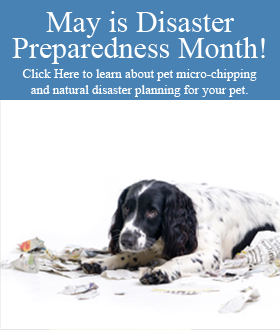We all like going to new and exciting places, even our dogs. And, if we’re lucky enough, we get to take our pets with us to enjoy the ride. So, whether you travel by car, truck, plane or train, help ensure a safe and pleasant journey with your dog by taking these safety precautions.
General Travel Tips
No matter what your mode of travel, the single best safe practice you can employ to keep your dog safe during your journey is to keep him restrained.
Affix a highly visible and durable pet ID tag to your pet and have him microchipped (don’t forget to register your microchip with the company). A tag is the first thing anyone looks at when they stop to help a pet and a microchip is a permanent form of ID to help ensure the return of your pet.
Carry a recent photograph of your pet to make it easier for others to help you look for him if he gets lost during the trip.
If your pet is prone to anxiety or motion sickness, consult your veterinarian prior to the trip about using pet tranquilizers that is appropriate for the particular time of travel you plan on taking.
Feed your pet their usual meal one to two hours prior to travel. (If your dog is prone to motion sickness, feed two to four hours prior to travel) Do not give food or water during travel as it may spill, forcing your pet to lie in a mess during the trip.
Cars and Trucks
Once again, no matter how long or short the journey, your pet should be restrained. An unrestrained pet is dangerous to himself and others. He can become a flying projectile that can injure you, your passengers or himself.
Secure your dog in the back seat (dogs riding in the front seat can be seriously hurt if the airbags deploy) with a pet travel safety harness or car seat or in a pet carrier fastened to a seatbelt. If you drive an SUV, install a pet carrier to keep the dog in the back area of the vehicle as well as securing him in his harness and attaching it to the hooks in the floor.
Do not allow your dog to ride with his head out of the window. Road debris and other flying objects can injure his eyes.
If you must transport your dog in the bed of a pickup, use a crate or a carrier secured to the truck bed to prevent him from being thrown into traffic at a sudden stop.
Before you set out on your journey and after arrive at your destination, give your dog plenty of exercise. This will help him be more relaxed and be able to acclimate to his new surroundings.
When stopping for a break and before you open the car door, attach a leash to your dog’s collar so he can’t escape. Even the most obedient pet can become disoriented when traveling. Always use a leash to walk your dog.
On a long car ride, stop every four hours or so to allow your dog to relieve himself (be sure to clean up after him), stretch his legs, refresh himself with a small drink of water and help him understand that he’s going to another environment.
Watch for temperature extremes. Your car is like an oven under the blazing sun and a freezer in the bitter cold.
Airline Travel
Whether your pet will go with you in the cabin or in the cargo hold, your pet will need to travel in an airline-approved carrier. Check with the airline website for requirements.
If your pet is travelling as cargo, check for restrictions on any health/immunization and other requirements.
Upon arrival at your destination, open the carrier as soon as you are in a safe place and clip a leash on your dog so you can safely examine him. If anything seems wrong, get to a veterinarian immediately.
Just remember, a happy, well-socialized dog that knows you will always be there to keep him safe and secure will enjoy traveling to new places with you. Happy Trails!
(*re-written with permission in part from Bark Busters Home Dog Training)





































